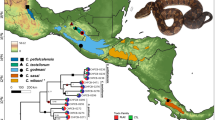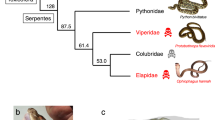Abstract
A remarkable diversity of venom peptides is expressed in the genus Conus (known as “conotoxins” or “conopeptides”). Between 50 and 200 different venom peptides can be found in a single Conus species, each having its own complement of peptides. Conopeptides are encoded by a few gene superfamilies; here we analyze the evolution of the A-superfamily in a fish-hunting species clade, Pionoconus. More than 90 conopeptide sequences from 11 different Conus species were used to build a phylogenetic tree. Comparison with a species tree based on standard genes reveals multiple gene duplication events, some of which took place before the Pionoconus radiation. By analysing several A-conopeptides from other Conus species recorded in GenBank, we date the major duplication events after the divergence between fish-hunting and non-fish-hunting species. Furthermore, likelihood approaches revealed strong positive selection; the magnitude depends on which A-conopeptide lineage and amino-acid locus is analyzed. The four major A-conopeptide clades defined are consistent with the current division of the superfamily into families and subfamilies based on the Cys pattern. The function of three of these clades (the κA-family, the α4/7-subfamily, and α3/5-subfamily) has previously been characterized. The function of the remaining clade, corresponding to the α4/4-subfamily, has not been elucidated. This subfamily is also found in several other fish-hunting species clades within Conus. The analysis revealed a surprisingly diverse origin of α4/4 conopeptides from a single species, Conus bullatus. This phylogenetic approach that defines different genetic lineages of Conus venom peptides provides a guidepost for identifying conopeptides with potentially novel functions.




Similar content being viewed by others
References
Aguilar MB, Chan de la Rosa RA, Falcon A, Olivera BM, Heimer de la Cotera EP (2009) Peptide pal9a from the venom of the turrid snail Polystira albida from the Gulf of Mexico: purification, characterization, and comparison with P-conotoxin-like (framework IX) conoidean peptides. Peptides 30:467–476
Azam L, Dowell C, Watkins M, Stitzel JA, Olivera BM, McIntosh JM (2005) Alpha-conotoxin BuIA, a novel peptide from Conus bullatus, distinguishes among neuronal nicotinic acetylcholine receptors. J Biol Chem 280:80–87
Conticello SG, Pilpel Y, Glusman G, Fainzilber M (2000) Position-specific codon conservation in hypervariable gene families. Trends Genet 16:57–59
Conticello SG, Gilad Y, Avidan N, Ben-Asher E, Levy Z, Fainzilber M (2001) Mechanisms for evolving hypervariability: the case of conopeptides. Mol Biol Evol 18:120–131
Doley R, Pahari S, Mackessy SP, Manjunatha Kini R (2008) Accelerated exchange of exon segments in viperid three-finger toxin genes (Sistrurus catenatus edwardsii; Desert Massasauga). BMC Evol Biol 8:196
Duda TF (2008) Differentiation of venoms of predatory marine gastropods: divergence of orthologous toxin genes of closely related Conus species with different dietary specializations. J Mol Evol 67:315–321
Duda TF, Kohn AJ (2005) Species-level phylogeography and evolutionary history of the hyperdiverse marine gastropod genus Conus. Mol Phylogenet Evol 34:257–272
Duda TF, Palumbi SR (1999) Molecular genetics of ecological diversification: duplication and rapid evolution of toxin genes of the venomous gastropod Conus. Proc Natl Acad Sci USA 96:6820–6823
Duda TF, Palumbi SR (2000) Evolutionary diversification of multigene families: allelic selection of toxins in predatory cone snails. Mol Biol Evol 17:1286–1293
Duda TF, Palumbi SR (2004) Gene expression and feeding ecology: evolution of piscivory in the venomous gastropod genus Conus. Proc Roy Soc Lond Ser B Biol Sci 271:1165–1174
Duda TF, Remigio A (2008) Variation and evolution of toxin gene expression patterns of six closely related venomous marine snails. Mol Ecol 17:3018–3032
Durand D, Halldorsson BV, Vernot B (2006) A hybrid micro-macroevolutionary approach to gene tree reconstruction. J Comput Biol 13:320–335
Espiritu DJD, Watkins M, Dia-Monje V, Cartier GE, Cruz LE, Olivera BM (2001) Venomous cone snails: molecular phylogeny and the generation of toxin diversity. Toxicon 39:1899–1916
Hall TA (1999) BioEdit: a user-friendly biological sequence alignment editor and analysis program for Windows 95/98/NT. Nucleic Acid Symp Ser 41:95–98
Huelsenbeck JP, Ronquist F, Hall B (2001) MrBayes: bayesian inference of phylogeny. Bioinformatics 17:754–755
Hughes AL, Friedman R (2008) Codon-based tests of positive selection, branch lengths, and the evolution of mammalian immune system genes. Immunogenetics 60:495–506
Keane TM, Creevey CJ, Pentony MM, Naughton TJ, McInerney JO (2006) Assessment of methods for amino acid matrix selection and their use on empirical data shows that ad hoc assumptions for choice of matrix are not justified. BMC Evol Biol 6:1–17
Kohn AJ (1990) Tempo and mode of evolution in Conidae. Malacologia 32:55–67
Ohno S (1970) Evolution by gene duplication. Springer, Berlin
Olivera BM (2006) Conus peptides: biodiversity-based discovery and exogenomics. J Biol Chem 281:31173–31177
Olivera BM (2008) Venom peptides from Conus and other Conoideans: prospects and perspectives. In: Benoit E, Goudey-Perrière F, Marchot P, Servent D (eds) Toxines et fonctions cholinergiques neuronales et non neuronales. Librairie Lavoisier, Cachan
Olivera BM, Teichert RW (2007) Diversity of the neurotoxic Conus peptides: a model for concerted pharmacological discovery. Mol Interv 7:251–260
Santos AD, Mc Intosh JM, Hillyard DR, Cruz LE, Olivera BM (2004) The A-superfamily of conotoxins: structural and functional divergence. J Biol Chem 279:17596–17606
Terlau H, Shon KJ, Grilley M, Stocker M, Stühmer W, Olivera BM (1996) Strategy for rapid immobilization of prey by a fish-hunting cone snail. Nature 381:148–151
Vernot B, Stolzer M, Goldman A, Durand D (2008) Reconciliation with non-binary species trees. J Comput Biol 15:981–1006
Wang Q, Jiang H, Hana Y-H, Yuan D-D, Chi C-W (2008) Two different groups of signal sequence in M-superfamily conotoxins. Toxicon 51:813–822
Watkins M, Hillyard DR, Olivera BM (2006) Genes expressed in a turrid venom duct: divergence and similarity to conotoxins. J Mol Evol 62:247–256
Wong WSW, Yang Z, Goldman N, Nielsen R (2004) Accuracy and power of statistical methods for detecting adaptive evolution in protein coding sequences and for identifying positively selected sites. Genetics 168:1041–1051
Woodward SR, Cruz LJ, Olivera BM, Hillyard DR (1990) Constant and hypervariable regions in conotoxin propeptides. EMBO 9:1015–1020
Yang Z (1998) Likelihood ratio tests for detecting positive selection and application to primate lysozyme evolution. Mol Biol Evol 15:568–573
Yang Z (2002) Inference of selection from multiple species alignments. Curr Opin Genetics Dev 12:688–694
Yang Z (2006) Computational molecular evolution. Oxford University Press, Oxford
Yang Z (2007) PAML 4: a program package for phylogenetic analysis by maximum likelihood. Mol Biol Evol 24:1586–1591
Yang Z, Bielawski JP (2000) Statistical methods for detecting molecular adaptation. Trends Ecol Evol 15:496–503
Yang Z, Nielsen R (1998) Synonymous and nonsynonymous rate variation in nuclear genes of mammals. J Mol Evol 46:409–418
Yang Z, Nielsen R, Hasegawa M (1998) Models of amino acid substitution and applications to mitochondrial protein evolution. Mol Biol Evol 15:1600–1611
Yang Z, Wong WSW, Nielsen R (2005) Bayes empirical Bayes inference of amino acid sites under positive selection. Mol Biol Evol 22:1107–1118
Zafaralla GC, Ramilo C, Gray WR, Karlstrom R, Olivera BM, Cruz LJ (1988) Phylogenetic specificity of cholinergic ligands: a-conotoxin SI. Biochemistry 27:7102–7105
Acknowledgments
This work was supported by NIH Program Project grant GM48677 (to BMO). We are pleased to thank Jon Seger, Nicole Kraus, Naoko Takezaki, and two anonymous reviewers for constructive comments on a previous version of the manuscript.
Author information
Authors and Affiliations
Corresponding author
Rights and permissions
About this article
Cite this article
Puillandre, N., Watkins, M. & Olivera, B.M. Evolution of Conus Peptide Genes: Duplication and Positive Selection in the A-Superfamily. J Mol Evol 70, 190–202 (2010). https://doi.org/10.1007/s00239-010-9321-7
Received:
Accepted:
Published:
Issue Date:
DOI: https://doi.org/10.1007/s00239-010-9321-7




